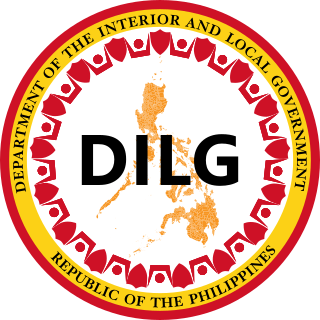
The Armed Forces of the Philippines (AFP) are the military forces of the Philippines. It consists of three main service branches; the Army, the Air Force, and the Navy. The President of the Philippines is the Commander-in-Chief of the AFP and forms military policy with the Department of National Defense, an executive department acting as the principal organ by which military policy is carried out, while the Chief of Staff of the Armed Forces of the Philippines serves as the overall commander and the highest-ranking officer in the AFP.

The Philippine Constabulary was a gendarmerie-type military police force of the Philippines from 1901 to 1991, and the predecessor to the Philippine National Police. It was created by the American occupational government to replace the Spanish colonial Guardia Civil, happened on the 19th century history of the Philippines. It was the first of the four branches of the Armed Forces of the Philippines. On January 29, 1991, it was merged with the Integrated National Police to form the Philippine National Police.
Sergeant is a rank in use by the armed forces of many countries. It is also a police rank in some police services. The alternative spelling, serjeant, is used in The Rifles and other units that draw their heritage from the British light infantry. Its origin is the Latin serviens, 'one who serves', through the French term sergeant.
Staff sergeant is a rank of non-commissioned officer used in the armed forces of many countries. It is also a police rank in some police services.
A master sergeant is the military rank for a senior non-commissioned officer in the armed forces of some countries.

Panfilo "Ping" Morena Lacson Sr. is a Filipino former politician and police general who served as a Senator for three terms: from 2001 to 2013 and from 2016 to 2022. He was the Director General of the Philippine National Police (PNP) from 1999 to 2001, and was a candidate in the 2004 and 2022 Philippine presidential elections.

A chief master sergeant is the military rank for a senior non-commissioned officer in the armed forces of some countries.

The Philippine National Police is the armed national police force in the Philippines. Its national headquarters is located at Camp Crame in Bagong Lipunan ng Crame, Quezon City. Currently, it has approximately 228,000 personnel to police a population in excess of 100 million.
The Philippine National Police Aviation Security Group (PNP-AVSEGROUP) is responsible for enforcing laws and regulations related to air travel in the Philippines.

The National Police Commission is an agency attached to the Department of the Interior and Local Government (DILG) responsible for the administration, financing, maintenance and control of the Philippine National Police (PNP) Personnel and Facilities. It has the authority to administer police entrance examination, to investigate police anomalies and irregularities, and to summarily dismiss erring police officers.

The Department of the Interior and Local Government, abbreviated as DILG, is the executive department of the Philippine government responsible for promoting peace and order, ensuring public safety and strengthening local government capability aimed towards the effective delivery of basic services to the citizenry.

The Integrated National Police (INP) was the municipal police force for the cities and large towns of the Republic of the Philippines. One of two national police forces in the country along with the Philippine Constabulary, it merged with the latter in 1991 to form the present Philippine National Police.
The Philippine Constabulary (PC) Metropolitan Command or MetroCom was created pursuant to Executive Order of President Ferdinand Marcos on July 14, 1967, to supplement police forces within the Greater Manila Area and combat all forms of criminal activity.

The Philippine National Police Maritime Group (PNP-MG) is a National Operational Support Unit (NOSU) of the Philippine National Police mandated to perform all police functions, ensure public safety and internal security over Philippine territorial waters, rivers and coastal areas to include ports and harbors and sustain the protection of the maritime environment. The unit was created along with the PNP by virtue of Republic Act RA 6975 otherwise known as Department of the Interior and Local Government Act of 1990 :

The National Capital Region Police Office (NCRPO) is a division of the Philippine National Police (PNP) that has jurisdiction over Metro Manila, also known as the National Capital Region. It is headquartered in Camp Bagong Diwa.

The Chief of the Philippine National Police is the head of the Philippines' national police body, the Philippine National Police (PNP). The position is invariably held by a Police General, a four-star general police officer.
The police in Canada's ranks differ according to the different police forces and depend on different laws at the federal, provincial, and municipal levels.

The Bureau of Fire Protection is the government body in the Philippines responsible for the provision of fire services. It is under the jurisdiction of the Department of the Interior and Local Government.











